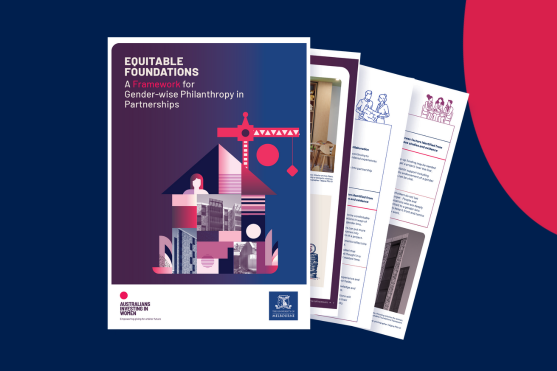Start your giving journey
Find the most effective way for you to give – as an individual, family, organisation or business – so you can focus on making an impact.

Learn and grow
Discover our collection of resources and tools to get you started, extend your giving, or support others on their giving journey.

Double giving by 2030
Our Blueprint to Grow Structured Giving outlines how the philanthropic, for-purpose, business and government sectors can work together to double structured giving from $2.5 billion in 2020 to $5 billion by 2030.

News and stories
New gender-wise resource launched to support philanthropic collaborations
Australians Investing In Women (AIIW) and the University of Melbourne’s Melbourne Social Equity Institute (MSEI) have launched a comprehensive resource to increase the impact of philanthropic and social investments.
Who were the two founding ‘godmothers’ of Philanthropy Australia?
In this fascinating look back in time, we share an archival story about the two women founders of Philanthropy Australia, first known as the Australian Association of Philanthropy (AAP). This extracted article is taken from a 1989 edition of our newsletter at the time, called Philanthropy. Pat Feilman and Meriel Wilmot are introduced as ‘the two people most instrumental in setting up the association’. In the interviews, they reflect on the state of philanthropy at the time, why they wanted to establish an association of philanthropists – and the initial reluctance of many in the sector to be involved.
A New Approach: How philanthropy and creativity are working together to turn Australia into a ‘cultural powerhouse’
Australia can become a powerhouse where arts and culture is a part of the day-to-day lives of Australians. A consortium of like-minded philanthropic bodies are working together to achieve exactly that. The organisation driving this effort is Australia’s leading arts and culture think tank, A New Approach (ANA).
A night celebrating philanthropy
The 2024 Australian Philanthropy Awards ceremony was held on Tuesday 16 April at the Art Gallery of NSW. More than 200 people packed Meers Hall to hear a showcase of the finalists across 9 categories and a surprise 10 Award recipients.
Stories of giving
Stories to inspire more and better philanthropy. Read about the experiences and motivations of the donors and the causes they are supporting.
Read our stories of givingPhilanthropy Australia National Conference 2022
Our 2022 national conference For the Love of Humanity – People, Place and Planet was a feast of ideas, insights and inspiration held over 3 days.
Read moreEvents
QLD Funders Peer Network
The Queensland Funders Peer Network brings together philanthropic organisations and funders based in Queensland. The network serves as a forum for collaborate, sharing insights, and exchanging best practices in philanthropy and grantmaking specifically within the Queensland context.
Subscribe to Philanthropy Weekly
Please complete your details here to subscribe to Philanthropy Australia’s weekly e-bulletin.
* required fields





